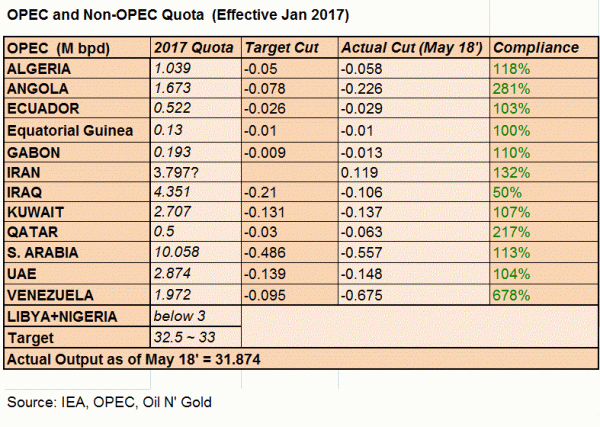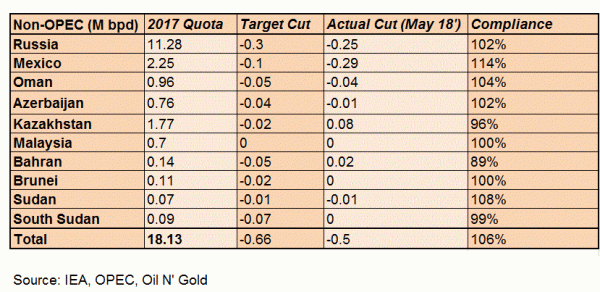Oil bulls are relieved after the OPEC/ non-OPEC decision on production. At the joint statement released on June 23, the oil producers announced that they would “strive to adhere to the overall conformity level, voluntarily adjusted to 100%, from July 1 and for the rest of the year. The Joint Ministerial Monitoring Committee (JMMC) would continue to monitor the overall conformity level. According to Saudi Energy Minister Khalid Al-Falih, “we have an agreement” for a “nominal” production increase of 1M bpd. Yet, the actual increase would be much less than that as many producers have already reached their “full capacity”. Oil ministers from Oman and Iraq estimated that the decision would result in production increase of about 600-700K bpd. The market was thrilled by the decision as it had anticipated a bigger increase in output (over 1M bpd). Both crude oil benchmarks rallied after the announcement. The front-month WTI contract jumped +4.64% while the Brent contract was up +3.42%. Wall Street’s energy shares also rallied with Exxon Mobil and Chevron gaining +2.1% and 2% on Friday. The S&P Energy index rose+2.2%, marking the sector’s biggest one-day increase since June.
Adherence to Compliance Represents a Boost
According the OPEC’s estimate, the conformity level (or compliance level) was at 149% in May 2018. Therefore, the decision to return the compliance level to 100%, meaning that the participants would cut production no more than the 1.2M bpd agreed in November 2016, implies an increase in production from the current levels. However, the statement was ambiguous in that it did not give details on which country would produce how much from July onwards, leaving the situation somehow uncertain.
Some producers Are Unable to Raise Output
Taking a look at May’s compliance level of above 150%, the key drive for the “over-compliance” was output disruption in Venezuela, where the oil sector collapsed as a result of US sanctions and economic crisis. The country had agreed to cut output by -0.1M bpd from the baseline supply of 2.07M bpd as of October 2016. Yet, the actual had reached -0.68M bpd in May, resulting in a 680% compliance level! Venezuelan president Nicolas Maduro pledged last month that his government aims at recovering the lost output by +1M bpd bpd this year. Yet, he admitted that it is “very challenging”. Angola and Iran also recorded “over-compliance” of about 280% and 132%, respectively. For non-OPEC producers, Mexico had cut its output by -0.29M bpd in May, almost tripling the agreed reduction of -0.1M bpd. These indicated that disruption at home has prohibited some producers from increasing output even though they might want to.
Saudi Arabia and Russia to Fill the Gap
The decision to “raise” output was in part a response to oil consuming countries. For instance, US’ Donald Trump has repeatedly complained about the rising oil price, urging OPEC to raise production, while Saudi Arabia has sent multiple signals, hoping to meet its demand. We expect Saudi Arabia and Russia would should much of the promised output increase. Indeed, Saudi already boosted its exports to 7.5M bpd, up +0.6M bpd, in June. Possessing over 20% of the world’s proven petroleum reserves and being the world’s largest exporter of petroleum, Saudi has both the interest and the capability to raise output. Meanwhile, Russia has from time signaled the intention to raise output and boost exports.














